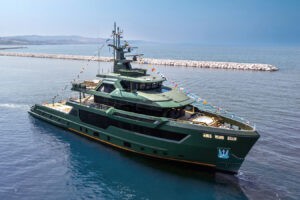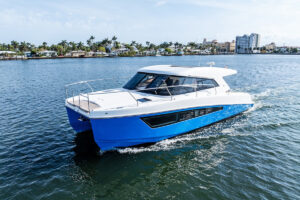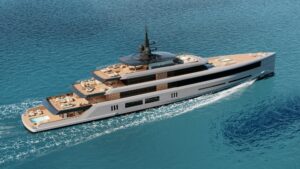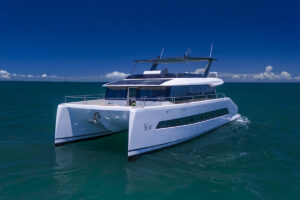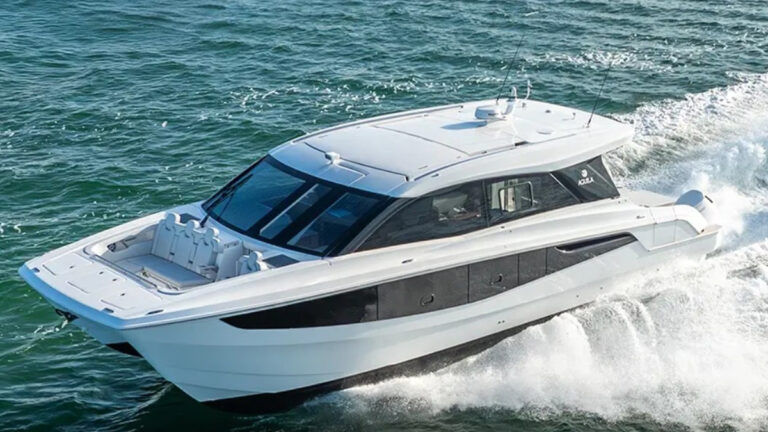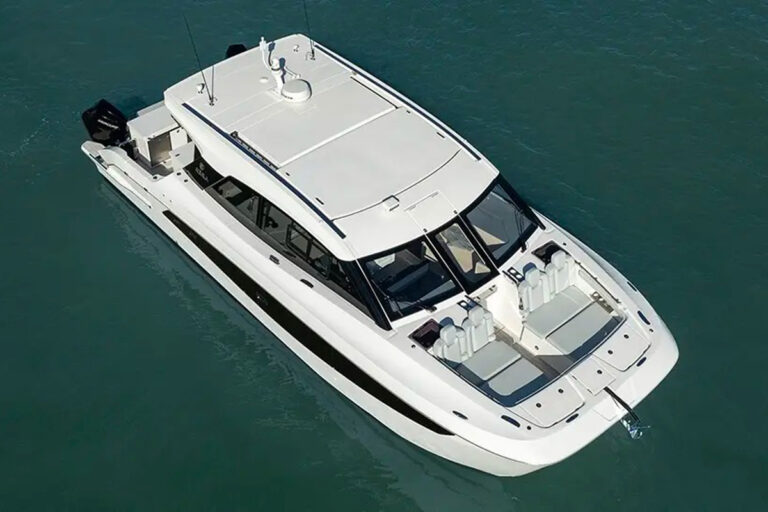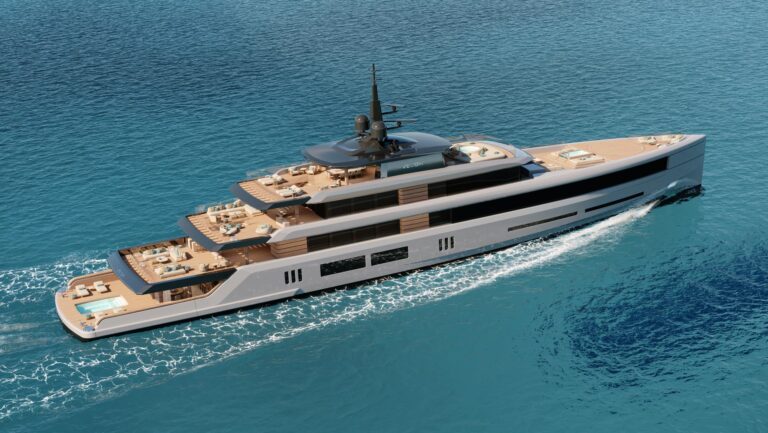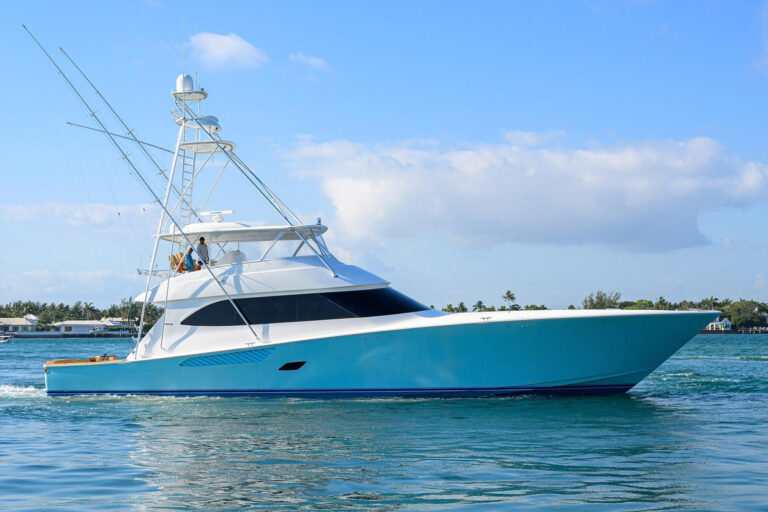Harbors and coastal waterways would be at a standstill were it not for the classic, dark-hulled tugboat. Ringed with castoffs from tire junkyards, the bearded stalwart is undaunted by Neptune’s forces as it completes workboat tasks. On a recent trip down a sliver of California’s coastline, the Nordic Tugs 52 convinced me that when pressed into service, she would make her workboat namesakes proud.
Nordic Tugs is a Washington State-based company, and its active employees are 10 percent owners. As I stowed my gear aboard hull number
one in Newport Beach, California, chairman and CEO Jim Cress inspected the engineroom in preparation for our 70-or-so-mile fog-shrouded jaunt to San Diego.
“This boat is a 26 on steroids”, Cress said.
More than 500 Tugs from 26 to 42 feet have been built to date. The 52-foot flagship of the Nordic Tugs fleet has a shape identical to that of the smaller models in the series, following directly the lines, profile and hull design the manufacturer has considered gospel since 1980.
We were sandwiched broadside on a floating dock. Cress walked the vessel sideways with a few twitches of the shifters and a couple of tickles of the joystick for the 25 hp hydraulic thruster. She is a substantial cruising yacht, almost 70,000 pounds, and can be easily operated by a couple.
Nordic Tugs braces the machinery space with watertight bulkheads and doors. The compartment is well lit and nicely proportioned, and all engine checks can be performed centerline. Racor filters are outboard of the 480 hp Cummins diesels, but there is no shortage of space to work. Wire runs are secure, neatly bundled and out of harm’s way. The yacht has a 400-gallon-per-day watermaker. A trash compactor is hidden belowdecks.
Somewhat surprising is that the 52 has two lurking hulks of diesel power rather than a large single. This is a departure for the builder. Cress found a single would not save much, if anything, in production costs. Besides, owners are enjoying the double-digit speeds. Some slow-go trawler purists no doubt will prefer a single, keeping that diesel under a proper load rather than light-loading twins; Nordic Tugs will oblige.
Outboard keels protect the running gear. With overbuilt rudders and a commercial-style Accu-Steer autopilot, the 52 is point-and-shoot responsive. She politely addressed a beam sea with a wave of her keel and a quick return to a staid track and our desired waypoint. Currently, she has no stabilizers, and the jury is still out on whether they will be added. We took little spray on our trip, but Cress said when it gets sloppy, the windshield wipers will see action.
Her sweet spot is around 2100 rpm, delivering a cruise of 14 knots and burning a miserly 27 gallons per hour; the engines were at 76 percent load. The test boat had an optional Aquadrive system that directs engine thrust to a separate bracket, taking pressure off the running gear and absorbing vibration. This helps keep the helm and saloon conversation-quiet. The easy-on-the-feet 3/16-inch cork sole in the galley, house and part of the saloon also cuts down on noise.
The tall, five-panel pilothouse windshield is far forward on the yacht, and skippers of any height have full view of what’s ahead and a peek at the transom with a slide to starboard. There is enough room to mount every conceivable navigation unit one could want. On the boat I ran, three marine radios coexisted nicely in the overhang. The optional Recaro helm seat is plush. I would like a companion chair, but not at the expense of losing the extended chart flat to starboard. The dinette settee works well, and the table with gaming inlay is stunning but not secure, a hazard in open waters. Sliding Sea Glaze doors offer access to the side decks for easy docking.
My only real beef is with the side decks: The rails and bulwarks are too low. Cress agreed and said the company is raising them 6 inches on future hulls and improving grab rails. Future hulls will also benefit from saloon windows lowered to improve visibility for those seated in the saloon. Aesthetically, her profile should accept the move.
Diesel fills are recessed into a cutout in the cabin house. Air plenums for the engineroom are slightly abaft the fills. An aggressive non-skid flows aft into the cockpit, an area sheltered by the bridge-deck overhang.
A cockpit ladder and teak stairs from the pilothouse lead to the bridge deck. The pilothouse entrance has a hatch and door. Both allow ambient light to enter the area. I opened the hatch while under way, and that kept things cool. Many manufacturers eliminate the cockpit egress, but I find it imperative for quick access, visibility and dealing with the tender housed above. The upper helm has a hydraulic jog lever-no steering wheel-with twin pedestal chairs and a settee with stowage below.
The large, full-beam owner’s stateroom, positioned low in the ship, withstands the least motion. During our trip, I was tempted to creep onto the king berth for a power nap. Vibration and decibel levels at cruise were comfortable. Helping to keep things quiet is the utility room, which falls between the cabin and engineroom.
Nordic Tugs designed the 52 with two staterooms, so it makes sense the forward guest stateroom is spacious, as well. Teak brings warmth to the living areas, and fit and finish are exacting and clean. A queen berth and an en suite head make this as comfortable as many master cabins.
Every area of the yacht had a perfect place to set a beverage, camera or writing pad. It is no wonder, then, that the saloon and galley are functional. The wide island counter has a double sink, offering more room to pile pots and pans. Appliances are on the forward bulkhead, and fiddles and roll guards are everywhere. The galley has two dual-voltage Sub-Zero refrigerators. Using one as a day fridge for quick retrieval of items will further conserve energy.
The saloon is trimmed with handsome teak, and the entertainment system is high in the cabinetry, offering even the chef a view. The décor of hull number one is not ornate, but the wood valences that hide the window treatments and eliminate unnecessary fabric are a classy touch. I would configure the units identically if she were my boat.
Attribute the rest of her good showing to construction. The hull is vacuum-bagged closed-cell foam above the waterline, solid below. Bulkheads are cored, and Nida-Core is used for the decks. The ship’s DC side is all 24-volt, with a 12-volt split under the helm, where a vital bus panel also is located.
Nordic Tugs has extended its line to 52 feet, but this was not a knee-jerk move. The process began more than six years ago, long before the fad of fast trawlers took hold. A couple will stand tall on this trawler yacht, because she’s built by a company of equally proud owners.
Contact: Nordic Tugs, (360) 757-8847; sales@nordictug.com; www.nordictug.com. For more information, contact: (866) 922-4877

